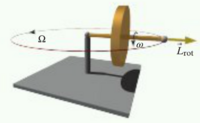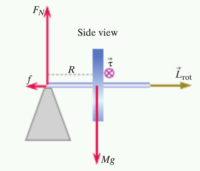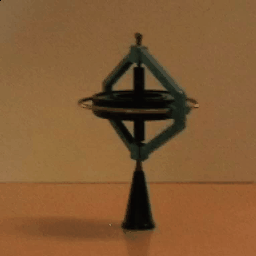Gyroscopes: Difference between revisions
Ansley Marks (talk | contribs) |
Ansley Marks (talk | contribs) No edit summary |
||
| Line 35: | Line 35: | ||
'''Lsupport = |''R'' x ''P'' | ''' | '''Lsupport = |''R'' x ''P'' | ''' | ||
Since the direction of the rotational angular momentum of the rotor around the support is constantly changing direction, the rate of change of the rotational angular momentum can be written as: | |||
'''LrotΩ''' | |||
Thus the only remaining element that is needed to complete the Angular Momentum Principle is the torque. The torque is equal to the distance from the support to the center of mass of the rotor, ''r'', multiplied by the force exerted, which is the mass times gravity. Therefore, since the change in rotational angular momentum is ''LrotΩ'', that must be equal to ''τCM''. By setting the two equations equal to each other, the angular momentum can be isolated to one side. This yields the following result: | |||
'''Ω = τCM/Lrot = ''r''Mg/''I''ω ''' | |||
===A Computational Model=== | ===A Computational Model=== | ||
| Line 84: | Line 92: | ||
Wikipedia: https://en.wikipedia.org/wiki/Gyroscope | Wikipedia: https://en.wikipedia.org/wiki/Gyroscope | ||
Gyroscope History: http://www.gyroscopes.org/history.asp | |||
[[Category: Angular Momentum]] | [[Category: Angular Momentum]] | ||
Revision as of 19:28, 2 December 2015
An explanation by Ansley Marks
A gyroscope is a device containing a wheel or disk that is free to rotate about its own axis independent of a change in direction of the axis itself. Since the spinning wheel persists in maintaining its plane of rotation, a gyroscopic effect can be observed.
The Main Idea
Although insignificant looking and seemingly uninteresting when still, gyroscopes become a fascinating device when in motion and can be explained using the angular momentum principle. Gyroscopes come in all different forms with varying parts. The main component of a gyroscope is a spinning wheel or a disk mounted on an axle. Typically gyroscopes contain a suspended rotor inside three rings called gimbals. In order to ensure that little torque is applied to the inside rotor, the gimbals are mounted on high quality bearing surfaces, allowing free movement of the spinning wheel in the middle. These types of gyroscopes with multiple gimbals are useful for stabilization because the wheels can change direction without affecting the inner rotor. If the spinning axle of a gyroscope is placed on a support, then a complex motion can be observed. The motion of a gyroscope will be modeled and explained further on in this page.
A Mathematical Model
When the spinning axis of a gyroscope is placed on a support, a gyroscopic effect is observed. The gyroscope bobs up and down--nutation--and rotates about the support--precession. For the sake of simplifying the mathematical equations for a gyroscope's motion, nutation (the upwards and downwards movement of the rotor) will be ignored. We will only look at the precession motion of the gyroscope.

To start off with, the gyroscope's rotor rotates about its own axis with an angular velocity of ω and has a moment of inertia I. Thus, the rotational angular momentum of the rotor can be modeled as:
Lrot,r = Iω
Where the rotational angular momentum points horizontal to the rotor.
The Lrot,r will always change direction as the rotor rotates about the support. The rotor processes about the support with an angular velocity Ω, which is constant in magnitude and direction.
If Ω is known, then the velocity of the center of mass of the rotor device can be derived using the following relationship:
Ω = Vcm/r
Where r is equal to the distance from the support to the center of mass of the rotor device. The linear momentum of the gyroscope is then ΩP.

Since the rotor is processing about the support, there must be a perpendicular force f exerted by the support such that ΩP = f, where P is equal to M(Ωr). Thus, f = Mr[math]\displaystyle{ Ω^2 }[/math].
There is also a translational angular momentum of the rotor processing about the support. This can be modeled by finding the magnitude of the position vector crossed with the momentum.
Lsupport = |R x P |
Since the direction of the rotational angular momentum of the rotor around the support is constantly changing direction, the rate of change of the rotational angular momentum can be written as:
LrotΩ
Thus the only remaining element that is needed to complete the Angular Momentum Principle is the torque. The torque is equal to the distance from the support to the center of mass of the rotor, r, multiplied by the force exerted, which is the mass times gravity. Therefore, since the change in rotational angular momentum is LrotΩ, that must be equal to τCM. By setting the two equations equal to each other, the angular momentum can be isolated to one side. This yields the following result:
Ω = τCM/Lrot = rMg/Iω
A Computational Model
How do we visualize or predict using this topic. Consider embedding some vpython code here Teach hands-on with GlowScript
Examples
Be sure to show all steps in your solution and include diagrams whenever possible
Simple
Middling
Difficult
Connectedness
- How is this topic connected to something that you are interested in?
- How is it connected to your major?
- Is there an interesting industrial application?
History
Gyroscopes have been around for nearly 200 years. The first person to discover the gyroscope was Johann Bohnenberger in 1817 at the University of Tubingen. However, Bohnenberger was not credited with the discovery of the gyroscope. The French scientist Jean Bernard Leon Foucault (1826-1864) coined the term "gyroscope" and ended up with being credited for the discovery of a gyroscope. Thanks to his experiments with the gyroscope, they started to become mainstream and studied by many other physicists. In the early 20th century, gyroscopes were first used in boats and eventually in aircraft. Gyroscopes have been modified and tweaked to suit many purposes that are widely used today mainly as stabilizers.
See also
Further reading
Compass and Gyroscope: Integrating Science and Politics for the Environment
Mathematical model for gyroscope effects: http://scitation.aip.org/content/aip/proceeding/aipcp/10.1063/1.4915651
YouTube video on gyroscope procession: https://www.youtube.com/watch?v=ty9QSiVC2g0
Wikipedia: https://en.wikipedia.org/wiki/Gyroscope
External links
http://dictionary.reference.com/browse/precession
http://dictionary.reference.com/browse/nutation
https://en.wikipedia.org/wiki/Gyroscope
References
Oxford Dictionaries: http://www.oxforddictionaries.com/us/definition/american_english/gyroscope
HyperPhysics: http://hyperphysics.phy-astr.gsu.edu/hbase/gyr.html
Wikipedia: https://en.wikipedia.org/wiki/Gyroscope
Gyroscope History: http://www.gyroscopes.org/history.asp
